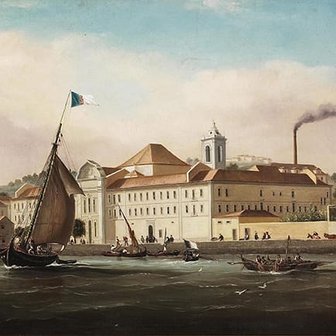ON THE INDUSTRIAL HISTORY OF PORTUGAL
Portugal was isolated within Europe for a long time: both by its location on the western edge of the continent and by a policy that sought little exchange with neighbouring nations and relied mainly on colonies: as early as the 15th century, the Portuguese built up a network of trading bases worldwide. In the 17th century, however, the pressure from competing nations became too great and Portugal concentrated on Brazil, which was rich in raw materials. The long-term consequences were fatal: when the flow of gold and diamonds from South America subsided, it was not possible to put the domestic economy on a different footing.
The Marquis de Pombal, "First Minister" in the 18th century, did try to counteract this: he founded one of the first commercial colleges in Europe, curtailed the influence of large landowners from the nobility and the church and established the Royal Silk Manufactory in 1758. Private glass and ironmongery businesses as well as woollen manufactories followed. But in agriculture, modernisation was unthinkable: In the south, it was dominated by arch-conservative landowners; in the north, it was in the hands of countless small farmers who farmed on the edge of subsistence, and so productivity remained low. Profits did not fall, so no significant market emerged and investment capital was lacking.
However, the sugar production of the Brazilian colony and the associated slave trade generated considerable income. Even after Brazil declared independence in 1822, the Portuguese continued to supply the plantations with slaves, mostly from their colony in Angola. Since Britain formally banned the slave trade in 1807, Portugal still shipped more than 2 million Africans to South America: more than any other country. It was not until 1869 that the government enacted a complete ban on slavery.
However, the influence of these profits on industrialisation in the "mother country" is difficult to determine. Not least because of the lack of mineral resources, only a few industrial islands formed there until the end of the 19th century: Textile production was the most successful, in particular the manufacture of woollens in Covilha. The tungsten mines near Fundão were another example, as were the expanding tobacco and cork processing, and paper, ceramics and glass manufacturing. In the mid 19th century, construction of a railway network commenced: the first trains connected Lisbon and Porto in 1864, with a link to Spain following in 1866. As the new industries settled primarily in the capital and in the Porto region, no new jobs were created in rural areas. The population grew dramatically, and tens of thousands were forced to emigrate.
Agriculture remained the backbone of the Portuguese economy until well into the 20th century. Improved cultivation methods and gradual mechanisation boosted production and an export trade in wine, fruit and cork developed, although grain imports were still necessary. The qualified workers and capital required for industrialisation were lacking. The fact that Portuguese foreign trade was dominated by Britain for a long time proved to be a further obstacle: much as the Portuguese economy had exploited the colonies as markets and raw-material suppliers, Great Britain exported technically advanced industrial goods to Portugal and in return procured agricultural products.
The isolationist policy of the dictatorial Salazar regime from 1932 to 1968 stifled progress for a long time, as the former economics professor once again focused on colonial exploitation. However, he succeeded in balancing the notoriously lopsided national finances and stabilising the currency. Additionally, labour costs were low, which made Portugal attractive to foreign investors. When the dictator finally loosened the reins in the 1960s, the long-delayed industrialisation began. The steel corporation Siderurgia Nacional expanded; Lisnave built new shipyards in Lisbon and Setenave in nearby Setúbal; paper factories, petrochemical companies and electrical equipment manufacturers emerged. The economy remained dominated by a small elite of a handful of families intermarried with the large landowners, but finally the process of structural change was completed.
When the dictatorship was overthrown in the Carnation Revolution of 1974, the pent-up desire for social change broke loose. In the agricultural south, numerous large landowners were expropriated, their roles taken over by cooperatives. The government in Lisbon gradually nationalised the key industries and the banks. But the socialist experiment did not last long. Drops in agricultural production gave the old elite a weapon for reversing most of the land expropriations. As the government had increased the wages and at the same time massively expanded its administration to carry out the new tasks of the state, a large hole once again emerged in the state’s finances. An austerity policy with wage cuts was instituted in 1976, and the subsequent years saw a re-privatisation of most industrial operations. In 1986, Portugal finally met the requirements for accession to the European Community, marking a long-overdue end to the era of isolation.


